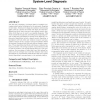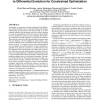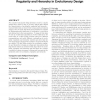GECCO
2005
Springer
15 years 1 months ago
2005
Springer
The size and complexity of systems based on multiple processing units demand techniques for the automatic diagnosis of their state. System-level diagnosis consists in determining ...
GECCO
2005
Springer
15 years 1 months ago
2005
Springer
In this paper, we incorporate a diversity mechanism to the differential evolution algorithm to solve constrained optimization problems without using a penalty function. The aim is...
GECCO
2005
Springer
15 years 1 months ago
2005
Springer
In many real-world design problems, uncertainties are often present and practically impossible to avoid. Many existing works on Evolutionary Algorithm (EA) for handling uncertaint...
GECCO
2005
Springer
15 years 1 months ago
2005
Springer
For computer-automated design systems to scale to complex designs they must be able to produce designs that exhibit the characteristics of modularity, regularity and hierarchy –...
GECCO
2005
Springer
15 years 1 months ago
2005
Springer
We present discrete stochastic mathematical models for the growth curves of synchronous and asynchronous evolutionary algorithms with populations structured according to a random ...
GECCO
2005
Springer
15 years 1 months ago
2005
Springer
This paper focuses on the computation time of evolutionary algorithms. First, some exact expressions of the mean first hitting times of general evolutionary algorithms in finite...
GECCO
2005
Springer
15 years 1 months ago
2005
Springer
A meta-GA (GA within a GA) is used to investigate evolving the parameter settings of genetic operators for genetic and evolutionary algorithms (GEA) in the hope of creating a self...
GECCO
2005
Springer
15 years 1 months ago
2005
Springer
This paper introduces an evolutionary algorithm which uses multiple chromosomes to evolve solutions to a symbolic regression problem. Inspiration for this algorithm is provided by...
GECCO
2005
Springer
15 years 1 months ago
2005
Springer
The identification of mechanisms by which constraints on phenotypic variability are tuned in nature, and the implementation of these mechanisms in Evolutionary Algorithms (EAs) ca...
EVOW
2005
Springer
15 years 1 months ago
2005
Springer
Computing consensus trees amounts to finding a single tree that summarizes a collection of trees. Three evolutionary algorithms are defined for this problem, featuring characteri...





